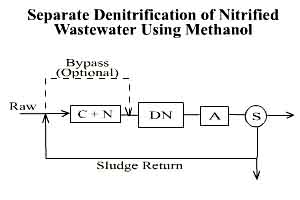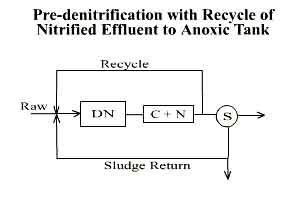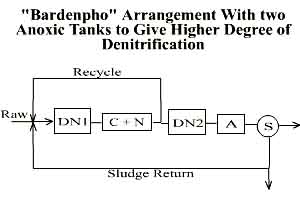Home
Lecture
Quiz
Design Example |
Biological Denitrification
Microbiological Aspects of Denitrification
Typical Flowsheets for Denitrification
Biological Denitrification
When a treatment plant discharges into receivingstream with
lowavailable nitrogen concentration and with a flow much larger
than the effluent, the presence of nitrate in the effluent generally
does not adversely affect stream quality. However,if the nitrate
concentration in the stream is significant, it may be desirable to
control the nitrogen contentof the effluent, as highly nitrified
effluents can stillaccelarate algal blooms. Even more critical is
the case where treatment plant effluent is dischargeddirectly into
relatively still bodies of water such as lakes or reservoirs. Another
argument for the controlof nitrogen in the aquatic environment is
theoccurence of infantile methemoglobinemia,which results
from high concentration of nitrates indrinking water.
The four basic processes that are used are: (1) ammonia stripping,
(2) selective ion exchange, (3) break point chlorination, and
(4) biological nitrification/denitrification.
Biological nitrification/denitrification is a two step process. The first step is nitrification, which is conversion of ammonia to nitrate through the action of nitrifying bacteria. The second step is nitrate conversion (denitrification), which is carried out by facultative heterotrophic bacteria under anoxic conditions.
Microbiological Aspects of Denitrification
-
Nitrate conversion takes place through both assimilatory and dissimilatory cellular functions. In assimilatory denitrification, nitrate is reduced to ammonia, which then serves as a nitrogen source for cell synthesis. Thus, nitrogen is removed from the liquid stream by incorporating it into cytoplasmic material.
-
In dissimilatory denitrification, nitrate serves as the electron acceptor in energy metabolism and is converted to various gaseous end products but principally molecular nitrogen, N2, which is then stripped from the liquid stream.
-
Because the microbial yield under anoxic conditions is considerably lower than under aerobic conditions, a relatively small fraction of the nitrogen is removed through assimilation. Dissimilatory denitrification is, therfore, the primary means by which nitrogen removal is achieved.
-
A carbon source is also essential as electron donor for denitrification to take place. This source may be in the form of carbon internally available in sewage or artificially added (eg. as methanol). Since most community wastewaters have a higher ratio of BOD:N, the internally available carbon becomes attractive and economical for denitrification.
Denitrification releases nitrogen which escapes as an inert gas to the atmosphere while oxygen released stays dissolved in the liquid and thus reduces the oxygen input needed into the system. Each molecule of nitrogen needs 4 molecules of oxygen during nitrification but releases back 2.5 molecules in denitrification. Thus, theoretically, 62.5% of the oxygen used is released back in denitrification.
Typical Flowsheets for Denitrification
Denitrification in suspended growth systems can be achieved using anyone of the typical flowsheets shown in the figure.
The use of methanol or any other artificial carbon source should be avoided as far as possible since it adds to the cost of treatment and also some operating difficulties may arise fro dosing rate of methanol. Too much would introduce an unnecessary BOD in the effluent while too little would leave some nitrates undernitrified.
-
A more satisfactory arrangement would be to use the carbon contained in the waste itself. However, the anoxic tank has to be of sufficient detention time for denitrification to occur which, has a slower rate; since the corresponding oxygen uptake rate of the mixed liquor is mainly due to endogenous respiration and is thus low. The denitrification rate, therefore, in a way also depends on the F/M ratio in the prior aeration tank.
-
Consequently, if desired, a portion of the raw waste may be bypassed to enter directly into the anoxic tank and thus contribute to an increased respiration rate. This reduces the sizes of both the anoxic and aeration tanks, but the denitrification efficiency is reduced as the bypassed unnitrified ammonia can not be denitrified.
-
By reversing the relative positions of anoxic and aerobic tanks, the oxygen requirement of the waste in its anoxic state is met by the release of oxygen from nitrates in the recycled flow taken from the end of nitrification tank. Primary settling of the raw waste may be omitted so as to bring more carbon into the anoxic tank.
-
More complete nitrification-denitrification can be achieved by Bardenpho arrangement. The first anoxic tank has the advantage of higher denitrification rate while the nitrates remaining in the liquor passing out of the tank can be denitrified further in a second anoxic tank through endogenous respiration.
- The flow from anoxic tank is desirable to reaerate for 10-15 minutes to drive off nitrogen gas bubbles and add oxygen prior to sedimentation.
 
 

. |